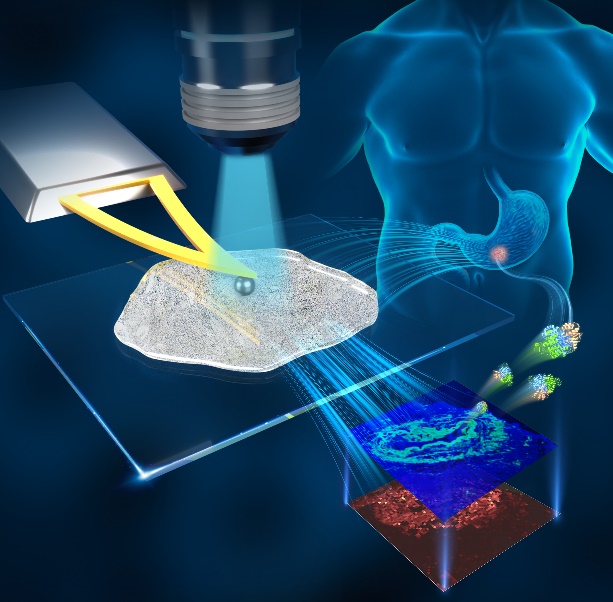
Regulatory Proteins Reveal Patterns of Gastric Cancer Invasion (Image by the research group)
Invasive metastasis of cancer is a major contributor to mortality, as evidenced by an increase in tissue stiffness that is closely associated with bioregulatory proteins.
Atomic force microscopy is a device capable of performing micro-nanomechanical measurements, however, the reduction of the overall mechanical properties of cancerous tissues is difficult to achieve due to the limitation of the measurement range. Due to the important role of regulatory proteins in life activities, constructing a correlation between tissue mechanics and bioregulatory proteins has been an ongoing goal for scientists.
Recently, researchers from the Shenyang Institute of Automation, Chinese Academy of Sciences, and China Medical University collaborated to construct a biofluorescence-mechanics co-labelling method through biological tissue cross-scale micro-nano mechanical measurement technology, which can simultaneously label the expression level of regulatory proteins and the hardness of cancer tissues. The related study was published in Nano Letters under the title “Impact of PSMD2 on Gastric Cancer Tissue Stiffness Investigated via Motor-Piezoceramic Coupled Atomic Force Microscopy”.
In Atomic Force In atomic force microscopy, piezoelectric ceramics move fast and travel small, while motors move slow and travel large. The research team significantly improved the scanning range and measurement efficiency of AFM's tissue measurement mechanics by combining the motor across a wide range of complex morphologies and the piezoelectric ceramics for small-scale precision measurements, thus realizing cross-scale mechanical measurements of gastric cancer tissue samples.
Combined with experiments on human gastric cancer tissues, the experimental results show that gastric cancer tissues in the region of high PSMD2 protein expression have significantly increased hardness and invasiveness. Meanwhile, the diffusion trend of high stiffness tissue in the co-labelled image compared with the PSMD2 region labelled by immunofluorescence showed the invasive tendency of gastric cancer cells. In addition, the statistical results showed a high linear correlation between the expression of PSMD2 and the increase in the hardness of gastric cancer tissues, revealing the key role of PSMD2 protein in the increase in the hardness of gastric cancer tissues, which provides a new target for gastric cancer treatment and research.

System Schematic (Image by the research group)
This research was supported by the National Natural Science Foundation of China (NSFC) project and the Key Research and Development Program of the Ministry of Science and Technology project.
Link to the paper: http://doi.org/10.1021/acs.nanolett.4c06514